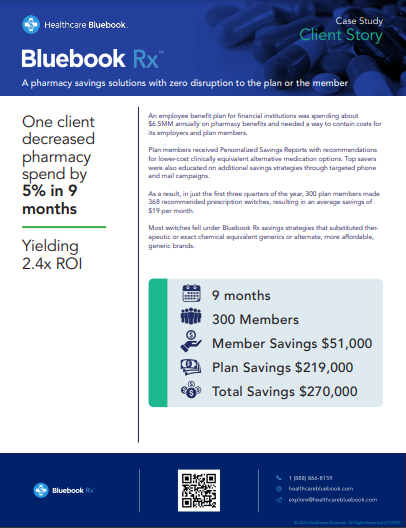-1.jpeg?width=1000&height=668&name=AdobeStock_894584095%20(1)-1.jpeg) Many health issues arise from obesity, such as high blood pressure, diabetes, heart disease, heart failure, and other conditions. Addressing obesity and other chronic health issues is critical to improving employee health. Today, there are drugs, such as glucagon-like peptide-1 (GLP-1) receptor agonists, to help employees manage weight and their risk for chronic conditions.
Many health issues arise from obesity, such as high blood pressure, diabetes, heart disease, heart failure, and other conditions. Addressing obesity and other chronic health issues is critical to improving employee health. Today, there are drugs, such as glucagon-like peptide-1 (GLP-1) receptor agonists, to help employees manage weight and their risk for chronic conditions.
The problem is that GLP-1 weight loss drugs aren’t cheap, and the demand for health plans to cover them is rising. Employers are in a unique position to help their workforce with obesity care, but they’re also facing several challenges with how they cover GLP-1s while keeping health plan costs reasonable. Below, we’re taking a look at how employers can address GLP-1 costs while ensuring employees have the tools they need, like Healthcare Bluebook, now part of Vālenz® Health, to manage chronic conditions.
The Impact of Obesity and Conditions Caused by Obesity
About half of adults in the U.S. will have obesity by 2030, which is especially concerning because obesity can cause other health conditions, and these conditions and the associated medical spending can have a large economic impact on the individual and their employer.
Obesity can lead to many chronic conditions, including diabetes, high blood pressure, high cholesterol, heart disease, heart failure, and kidney disease. As a result of these conditions, employees may take more time off work, visit more specialists, spend more on healthcare, and potentially perform poorly at work.
How Employers Can Help Employees Manage Obesity and Chronic Conditions
Deciding how to cover GLP-1 weight loss drugs in a health plan is one of the largest decisions employers have to make. Should they cover diabetes, weight management, or both? The decision isn’t easy. Along with this, employers also need to decide which strategies they’ll implement to cover GLP-1s while keeping healthcare costs reasonable.
Review coverage.
Check if your health plan currently covers GLP-1s for weight loss and assess if there are any restrictions on eligibility based on body mass index (BMI) or other factors. While you’re reviewing your health plan, also take time to review every employee’s medical history so you can develop a better understanding of how their weight has had an impact on their health. Knowing this information can help guide your coverage decisions.
Take a holistic approach.
Weight loss drugs alone don’t help deliver sustained results. Ensure employees have the tools they need to be successful by taking a holistic approach and offering a comprehensive weight management program that includes regular check-ins, medication adherence monitoring, information on nutrition counseling, fitness classes, and behavioral support alongside medication access.
This approach ensures employers consider several components that could have an impact on obesity, such as mental health, addiction, and nutrition. The goal of lifestyle intervention programs is to ensure that an individual continues to be successful with their weight management journey after being taken off GLP-1s if the drug isn’t required for an underlying condition.
Consider cost management options.
Evaluate different GLP-1 options and work with your insurance carrier to find the most cost-effective solutions to ensure employees have the medications they need without impacting their (or your) budget. It’s also beneficial to explore alternate Rx sourcing arrangements, such as Bluebook Rx™, which can help reduce pharmacy costs by evaluating claims data to determine where overpriced medications are used. Then, members receive a personalized report suggesting lower-cost alternatives.
Bluebook Rx has also expanded to focus on GLP-1 weight loss drugs. The program enables employers and members to save money on GLP-1s while ensuring access to necessary medications with this lower-cost bundled solution.
Ensure transparency and open communication.
Clearly communicate to employees about the availability of GLP-1 coverage and how to access it through their health plan. Also make sure to explain eligibility requirements, such as prior authorization requirements or BMI thresholds.
To keep an open line of communication about GLP-1 coverage with employees, keep your online benefits portal up to date with GLP-1 coverage information, host informational employee meetings where you can answer employee questions and address their concerns, and provide access to the benefits administrator or human resources department so they can reach out with questions.
How Healthcare Bluebook Can Help with GLP-1 Weight Loss Drug Coverage
About 20 percent of medical spending consists of pharmacy costs, and with prescription drug costs on the rise—combined with the popularity and cost of GLP-1 weight loss drugs—employers need a smarter, lower-cost solution. Healthcare Bluebook, now part of Valenz, and its pharmacy program, Bluebook Rx, has identified savings opportunities for numerous members and their employers.
Learn more about how other companies have integrated Bluebook Rx into their health plan and the results they experienced in our case study.

